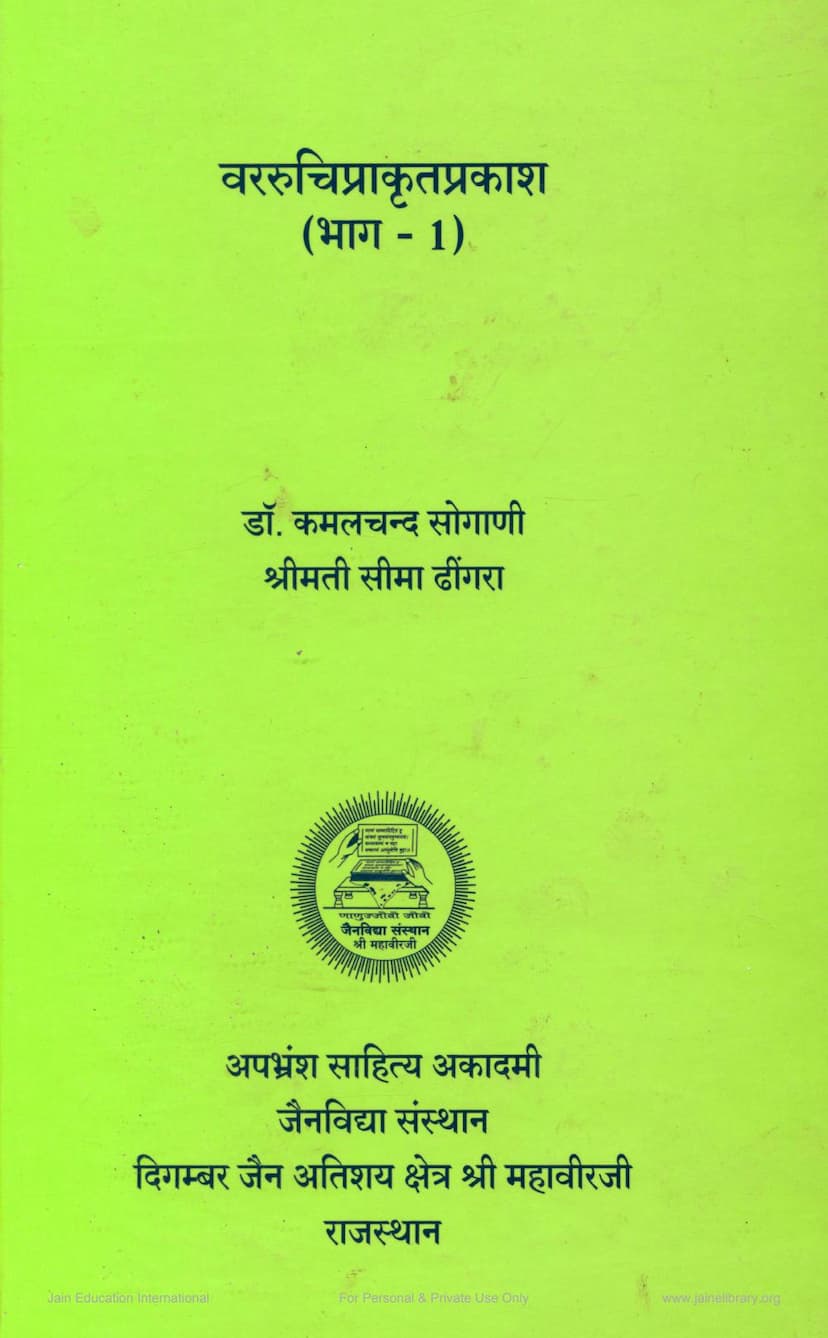Varruchi Prakrit Prakash Part 01
Added to library: September 2, 2025

Summary
Here is a comprehensive summary of the provided Jain text, "Varruchi Prakrit Prakash Part 01":
Book Title: Varruchi Prakrit Prakash Part 01 Authors: Dr. Kamalchand Sogani, Shrimati Seema Dhingra Publisher: Apbhramsa Sahitya Academy Affiliated Institutions: Jain Vidya Sansthan, Shri Mahavirji, Rajasthan Publication Year: 2010 (First Edition)
Overall Purpose: This book is a detailed analysis and explanation of the noun (संज्ञा - Sangya) and pronoun (सर्वनाम - Sarvanama) sutras from Vararuci's "Prakrit Prakash." It aims to make the study of Prakrit accessible to learners by breaking down the complex sutras into understandable steps, assuming only a basic knowledge of Sanskrit or even general grammatical principles.
Key Content and Structure:
-
Introduction (प्रकाशकीय - Prakashakiya):
- Highlights the significance of Prakrit as the language of the common people and the medium used by Lord Mahavir for his teachings.
- Emphasizes Prakrit's evolution into Apabhramsa and its role as a source for modern Indian languages like Hindi.
- States that understanding Prakrit is essential for studying modern Indo-Aryan languages.
- Introduces Vararuci's "Prakrit Prakash" as a foundational and highly influential grammar text, composed in Sanskrit but dealing with Prakrit rules. It notes the book's popularity and the existence of numerous commentaries due to its clarity and comprehensiveness.
- Specifies that this particular volume focuses on the sutras related to nouns and pronouns (fifth and sixth chapters of the original text).
- Mentions the establishment of the Apabhramsa Sahitya Academy under the Jain Vidya Sansthan, Shri Mahavirji, in 1988, dedicated to the teaching of Prakrit and Apabhramsa via correspondence.
-
Sutra Analysis Methodology (सूत्र - विवेचन):
- The book explains that Vararuci's sutras, though in Sanskrit, are designed to be understood with minimal Sanskrit knowledge. Familiarity with Hindi or English grammar is also helpful.
- Understanding sandhi rules (vowel, consonant, visarga) and Sanskrit case endings (vibhakti) is necessary.
- Prakrit has only two numbers: singular (एकवचन) and plural (बहुवचन).
- The book breaks down the analysis of each sutra into five steps:
- Sandhi vicched (breaking down compound words).
- Identifying the case and number of words.
- Literal meaning of the words.
- Overall meaning in context.
- Examples of usage.
-
Detailed Sutra Explanations (संज्ञा - प्रकरण & सर्वनाम - प्रकरण):
- Nouns (Sangya): The book systematically presents sutras governing the formation of noun declensions. It provides examples for masculine, neuter, and feminine nouns, including common examples like:
- Masculine: Dev (अकारान्त), Hari (इकारान्त), Gamani (इकारान्त), Sahu (उकारान्त), Sayamphu (ऊकारान्त), Piara/Piu (पिता), Ra'a (राजा), Appa/Appana (आत्मा).
- Neuter: Kamal (अकारान्त), Vari (इकारान्त), Mahu (उकारान्त).
- Feminine: Kaha (आकारान्त), Mai (इकारान्त), Lacchi (ईकारान्त), Dhenu (उकारान्त), Bahu (ऊकारान्त).
- Pronouns (Sarvanama): The text then proceeds to explain the declensions of various pronouns, including:
- General: Savva (all).
- Demonstrative/Interrogative/Relative: Ta (that), Ja (who/which), Ka (who), Et (this), Im (this), Amu (that), Amha (we), Tumha (you).
- The explanations often include cross-references to specific sutras governing the changes in case endings, root vowels, and suffixes.
- The text meticulously lists the different cases (prathama, dvitiya, trtiya, caturthi, pancami, ṣaṣṭhi, saptami, sambodhana) and numbers (ekavachana, bahuvachana) for each noun and pronoun type, showing the Prakrit forms derived from the Sanskrit originals through the application of Vararuci's rules.
- Special attention is given to the unique declension patterns of certain pronouns and their gender variations (masculine, neuter, feminine).
- Nouns (Sangya): The book systematically presents sutras governing the formation of noun declensions. It provides examples for masculine, neuter, and feminine nouns, including common examples like:
-
Appendices (परिशिष्ट):
- Appendix 1: Commentaries on Prakrit Prakash (प्राकृतप्रकाश की टीकाएँ): Briefly discusses major Sanskrit commentaries on Vararuci's work, including:
- Manorama by Bhamaha (5th century) - the oldest and most popular.
- Prakritamanjari - poetic commentary, authorship debated.
- Prakritasanjivani by Vasantraja (14th century) - detailed and influential.
- Subodhini by Sadananada (15th-17th century) - a shorter version of Prakritasanjivani.
- Chandrika by Mathuraprasad Dikshit - modern Sanskrit commentary.
- Mentions other commentaries like Prakritavritti by Ramapanivad and Prakritadipika by Narayan Vinod, and commentaries in other languages, underscoring the work's importance.
- Appendix 2: Sandhi Rules Used in the Sutras (सूत्रों में प्रयुक्त सन्धि-नियम): Lists common sandhi (joining) rules applicable in Prakrit formation, categorized into vowel sandhi, consonant sandhi, and visarga sandhi, with examples from the sutras.
- Appendix 3: Grammatical Analysis of Sutras (सूत्रों का व्याकरणिक विश्लेषण): Provides a table detailing each sutra, its number, the sandhi rules involved, the original Sanskrit root word, the specific case/number, and the resulting Prakrit form, along with the rules applied. This serves as a cross-reference and analytical tool.
- Appendix 4: Helpful Books and Dictionaries (सहायक पुस्तकें एवं कोश): Lists relevant reference materials for Prakrit study.
- Appendix 1: Commentaries on Prakrit Prakash (प्राकृतप्रकाश की टीकाएँ): Briefly discusses major Sanskrit commentaries on Vararuci's work, including:
Target Audience: Students and scholars interested in learning Prakrit, particularly those focusing on the grammatical system as codified by Vararuci. It is also valuable for those studying the evolution of Indo-Aryan languages and Jain literature.
Contribution: This work makes a significant contribution by providing a structured and pedagogical approach to understanding a foundational text of Prakrit grammar. By dissecting the sutras and illustrating them with detailed declension tables, it demystifies complex grammatical concepts and facilitates practical application for learners. The inclusion of multiple appendices enhances its utility as a reference and study aid.